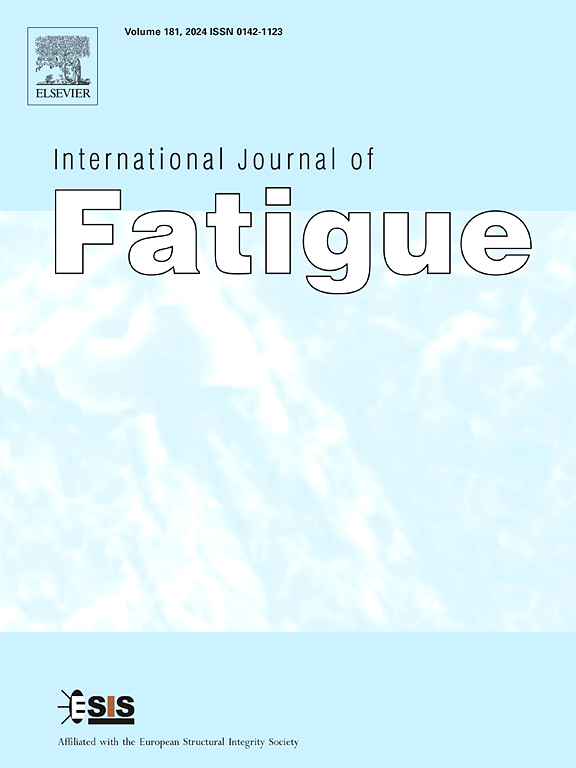Fatigue behavior and failure mechanism of friction self-piercing riveted aluminum alloy 2060-T8 joints
IF 5.7
2区 材料科学
Q1 ENGINEERING, MECHANICAL
引用次数: 0
Abstract
Friction self-piercing riveting (F-SPR) provides an enabling technology for high efficiency and reliability joining of thin-walled structures in the aviation field. However, there is still a lack of quantitative understanding of the F-SPR joints fatigue performance, hindering its engineering application. For this purpose, the forming characteristics, static mechanical and fatigue properties of aluminum alloy 2060-T8 flat die F-SPR lap joints are systematically investigated by experiments. X-ray microscope is used to conduct a non-destructive observation for the crack initiation and propagation processes in the F-SPR joint under cyclic loads. A three-dimensional finite element model is developed to further reveal its stress distribution and failure mechanism. Two typical fatigue failure modes are identified, one is the rivet shear fracture accompanied by incomplete lower sheet fracture for high load level, the other is the lower sheet fracture under the rivet tip for low load level. Different from the low load level condition, the fracture position of the lower sheet at high load level is the contact surface between the sheets outside the rivet shank, which can be attributed to the stress concentration and the severe fretting wear. Moreover, numerical simulation indicates that the stress concentration of the rivet is mainly located at the groove under the rivet cap, and the stress in the sheets is concentrated at the rivet tip and the contact surface, which could well explain the experimental results.
铝合金2060-T8摩擦自穿铆接接头疲劳行为及失效机理
摩擦自穿铆接技术为航空领域薄壁结构的高效、可靠连接提供了一种使能技术。然而,目前对F-SPR接头疲劳性能的定量认识还不够,阻碍了其工程应用。为此,通过实验系统地研究了2060-T8铝合金平模F-SPR搭接件的成形特性、静态力学性能和疲劳性能。利用x射线显微镜对循环载荷作用下F-SPR接头的裂纹萌生和扩展过程进行了无损观察。建立了三维有限元模型,进一步揭示了其应力分布和破坏机理。确定了两种典型的疲劳破坏模式,一种是高载荷水平下铆钉剪切断裂伴随下片不完全断裂,另一种是低载荷水平下铆钉尖端下片断裂。与低载荷水平条件不同,高载荷水平下下片材断裂位置为铆钉柄外片材之间的接触面,这可归因于应力集中和严重的微动磨损。数值模拟结果表明,铆钉的应力集中主要集中在铆钉帽下的凹槽处,板料中的应力集中在铆钉尖端和接触面处,这很好地解释了实验结果。
本文章由计算机程序翻译,如有差异,请以英文原文为准。
求助全文
约1分钟内获得全文
求助全文
来源期刊

International Journal of Fatigue
工程技术-材料科学:综合
CiteScore
10.70
自引率
21.70%
发文量
619
审稿时长
58 days
期刊介绍:
Typical subjects discussed in International Journal of Fatigue address:
Novel fatigue testing and characterization methods (new kinds of fatigue tests, critical evaluation of existing methods, in situ measurement of fatigue degradation, non-contact field measurements)
Multiaxial fatigue and complex loading effects of materials and structures, exploring state-of-the-art concepts in degradation under cyclic loading
Fatigue in the very high cycle regime, including failure mode transitions from surface to subsurface, effects of surface treatment, processing, and loading conditions
Modeling (including degradation processes and related driving forces, multiscale/multi-resolution methods, computational hierarchical and concurrent methods for coupled component and material responses, novel methods for notch root analysis, fracture mechanics, damage mechanics, crack growth kinetics, life prediction and durability, and prediction of stochastic fatigue behavior reflecting microstructure and service conditions)
Models for early stages of fatigue crack formation and growth that explicitly consider microstructure and relevant materials science aspects
Understanding the influence or manufacturing and processing route on fatigue degradation, and embedding this understanding in more predictive schemes for mitigation and design against fatigue
Prognosis and damage state awareness (including sensors, monitoring, methodology, interactive control, accelerated methods, data interpretation)
Applications of technologies associated with fatigue and their implications for structural integrity and reliability. This includes issues related to design, operation and maintenance, i.e., life cycle engineering
Smart materials and structures that can sense and mitigate fatigue degradation
Fatigue of devices and structures at small scales, including effects of process route and surfaces/interfaces.
 求助内容:
求助内容: 应助结果提醒方式:
应助结果提醒方式:


